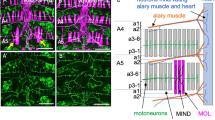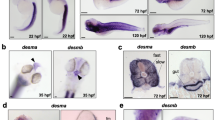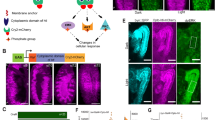Abstract
The internal organs of animals often have left–right asymmetry1,2. Although the formation of the anterior–posterior and dorsal–ventral axes in Drosophila is well understood, left–right asymmetry has not been extensively studied. Here we find that the handedness of the embryonic gut and the adult gut and testes is reversed (not randomized) in viable and fertile homozygous Myo31DF mutants. Myo31DF encodes an unconventional myosin, Drosophila MyoIA (also referred to as MyoID in mammals; refs 3, 4), and is the first actin-based motor protein to be implicated in left–right patterning. We find that Myo31DF is required in the hindgut epithelium for normal embryonic handedness. Disruption of actin filaments in the hindgut epithelium randomizes the handedness of the embryonic gut, suggesting that Myo31DF function requires the actin cytoskeleton. Consistent with this, we find that Myo31DF colocalizes with the cytoskeleton. Overexpression of Myo61F, another myosin I (ref. 4), reverses the handedness of the embryonic gut, and its knockdown also causes a left–right patterning defect. These two unconventional myosin I proteins may have antagonistic functions in left–right patterning. We suggest that the actin cytoskeleton and myosin I proteins may be crucial for generating left–right asymmetry in invertebrates.
This is a preview of subscription content, access via your institution
Access options
Subscribe to this journal
Receive 51 print issues and online access
$199.00 per year
only $3.90 per issue
Buy this article
- Purchase on Springer Link
- Instant access to full article PDF
Prices may be subject to local taxes which are calculated during checkout



Similar content being viewed by others
References
Wood, W. B. Left–right asymmetry in animal development. Annu. Rev. Cell Dev. Biol. 13, 53–82 (1997)
Mercola, M. & Levin, M. Left–right asymmetry determination in vertebrates. Annu. Rev. Cell Dev. Biol. 17, 779–805 (2001)
Gillespie, P. G. et al. Myosin-I nomenclature. J. Cell Biol. 155, 703–704 (2001)
Morgan, N. S., Heintzelman, M. B. & Mooseker, M. S. Characterization of Myosin-IA and Myosin-IB, two unconventional myosins associated with the Drosophila brush border cytoskeleton. Dev. Biol. 172, 51–71 (1995)
Hayashi, T. & Murakami, R. Left–right asymmetry in Drosophila melanogaster gut development. Dev. Growth Differ. 43, 239–246 (2001)
Ligoxygakis, P., Strigini, M. & Averof, M. Specification of left–right asymmetry in the embryonic gut of Drosophila. Development 128, 1171–1174 (2001)
Hayashi, M. et al. Left–right asymmetry in the alimentary canal of the Drosophila embryo. Dev. Growth Differ. 47, 457–460 (2005)
Pascual, A., Huang, K, Neven, J. & Préat, T. Neuroanatomy: Brain asymmetry and long-term memory. Nature 427, 605–606 (2004)
Adam, G., Perrimon, N. & Noselli, S. The retinoic-like juvenile hormone controls the looping of left–right asymmetric organs in Drosophila. Development 130, 2397–2406 (2003)
Spéder, P., Ádám, G. & Noselli, S. Type ID unconventional myosin controls left–right asymmetry in Drosophila. Nature doi:10.1038/nature04623 (this issue)
Iwaki, D. D. & Lengyel, J. A. A Delta–Notch signaling border regulated by Engrailed/Inverted repression specifies boundary cells in the Drosophila hindgut. Mech. Dev. 114, 71–84 (2002)
Wodarz, A., Hinz, U., Engelbert, M. & Knust, E. Expression of crumbs confers apical character on plasma membrane domains of ectodermal epithelia of Drosophila. Cell 82, 67–76 (1995)
Edwards, K. A., Demsky, M., Montague, R. A., Weymouth, N. & Kiehart, D. P. GFP–moesin illuminates actin cytoskeleton dynamics in living tissue and demonstrates cell shape change during morphogenesis in Drosophila. Dev. Biol. 191, 103–117 (1997)
McGuire, S. E. et al. Spatiotemporal rescue of memory dysfunction in Drosophila. Science 302, 1765–1768 (2003)
Etienne-Manneville, S. & Hall, A. Rho GTPases in cell biology. Nature 420, 629–635 (2002)
Iwaki, D. D., Johansen, K. A., Singer, J. B. & Lengyel, J. A. drumstick, bowl, and lines are required for patterning and cell rearrangement in the Drosophila embryonic hindgut. Dev. Biol. 240, 611–626 (2001)
Gillespie, P. G., Wagner, M. C. & Hudspeth, A. J. Identification of a 120 kd hair-bundle myosin located near stereociliary tips. Neuron 11, 581–594 (1993)
Shibazaki, Y., Shimizu, M. & Kuroda, R. Body handedness is directed by genetically determined cytoskeletal dynamics in the early embryo. Curr. Biol. 14, 1462–1467 (2004)
Huber, L. A. et al. Both calmodulin and unconventional myosin Myr4 regulate membrane trafficking along the recycling pathway of MDCK cells. Traffic 1, 494–503 (2000)
Brand, A. H. & Perrimon, N. Targeted gene expression as a means of altering cell fates and generating dominant phenotypes. Development 118, 401–415 (1993)
Martin-Bermudo, M. D., Dunin-Borkowski, O. M. & Brown, N. B. Specificity of PS integrin function during embryogenesis resides in the α subunit extracellular domain. EMBO J. 16, 4184–4193 (1997)
Tracey, W. D. Jr, Ning, X., Klingler, M., Kramer, S. G. & Gergen, J. P. Quantitative analysis of gene function in the Drosophila embryo. Genetics 154, 273–284 (2000)
Strutt, D. I., Weber, U. & Mlodzik, M. The role of RhoA in tissue polarity and Frizzled signaling. Nature 387, 292–295 (1997)
Luo, L., Liao, Y. J., Jan, L. Y. & Jan, Y. N. Distinct morphogenetic functions of similar small GTPases: Drosophila Drac1 is involved in axonal outgrowth and myoblast fusion. Genes Dev. 8, 1787–1802 (1994)
Eaton, S., Auvinen, P., Luo, L., Jan, Y. N. & Simons, K. CDC42 and Rac1 control different actin-dependent processes in the Drosophila wing epithelium. J. Cell Biol. 131, 151–164 (1995)
Sullivan, W., Ashburner, M. & Hawley, R. S. Drosophila Protocols (Cold Spring Harbor Laboratory Press, New York, 2000)
Patel, N. H., Snow, P. M. & Goodman, C. S. Characterization and cloning of fasciclin III: a glycoprotein expressed on a subset of neurons and axon pathways in Drosophila. Cell 48, 975–988 (1987)
Frydman, H. M. & Spradling, A. C. The receptor-like tyrosine phosphatase Lar is required for epithelial planar polarity and for axis determination within Drosophila ovarian follicles. Development 128, 3209–3220 (2001)
Jiang, J., Kosman, D., Ip, Y. T. & Levine, M. The dorsal morphogen gradient regulates the mesoderm determinant twist in early Drosophila embryos. Genes Dev. 5, 1881–1891 (1991)
Rogers, S. L., Rogers, G. C., Sharp, D. J. & Vale, R. D. Drosophila EB1 is important for proper assembly, dynamics, and positioning of the mitotic spindle. J. Cell Biol. 158, 873–884 (2002)
Acknowledgements
We thank the Developmental Studies Hybridoma Bank at the University of Iowa, the Bloomington Stock Center, and the Drosophila Genetic Resource Center at the Kyoto Institute of Technology. We thank J. Lengyel for byn–Gal4 and S. Hayashi for UAS-gfp–moesin transgenic strains. This work was supported by grants-in-aid from the Japanese Ministry of Education, Culture, Sports and Science. Author Contributions Experimental work was performed by S.H., R.M., K.T., M.K., S.S., T.S., P.S. and T.A. Data analysis was by S.H., R.M., K.T. and K.M., and project planning was coordinated by S.N., R.M. and K.M.
Author information
Authors and Affiliations
Corresponding author
Ethics declarations
Competing interests
Reprints and permissions information is available at npg.nature.com/reprintsandpermissions. The authors declare no competing financial interests.
Supplementary information
Supplementary Tables
This file contains Supplementary Tables 1 and 2. Supplementary Table 1 summarizes the results of this paper as the percentage of individual animals with handedness defects in each mutant or expression line. Supplementary Table 2 shows the phenocritical periods for inducing the LR defect by Myo31DF knockdown and by GFP–Moe misexpression. (PDF 136 kb)
Rights and permissions
About this article
Cite this article
Hozumi, S., Maeda, R., Taniguchi, K. et al. An unconventional myosin in Drosophila reverses the default handedness in visceral organs. Nature 440, 798–802 (2006). https://doi.org/10.1038/nature04625
Received:
Accepted:
Issue Date:
DOI: https://doi.org/10.1038/nature04625
This article is cited by
-
Unconventional colloidal aggregation in chiral bacterial baths
Nature Physics (2023)
-
Actin polymerisation and crosslinking drive left-right asymmetry in single cell and cell collectives
Nature Communications (2023)
-
Membrane-bound myosin IC drives the chiral rotation of the gliding actin filament around its longitudinal axis
Scientific Reports (2023)
-
Asymmetric activity of NetrinB controls laterality of the Drosophila brain
Nature Communications (2023)
-
Bryophytes as Modern Model Plants: An Overview of Their Development, Contributions, and Future Prospects
Journal of Plant Growth Regulation (2023)
Comments
By submitting a comment you agree to abide by our Terms and Community Guidelines. If you find something abusive or that does not comply with our terms or guidelines please flag it as inappropriate.



